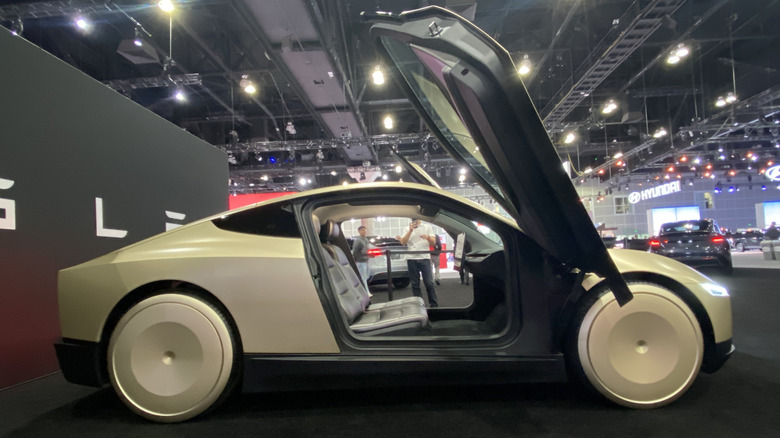After years of broken promises, delayed launch events, and empty platitudes from Tesla about their cars, their car’s capabilities, and what is possible with features like “Autopilot,” I’ve grown pretty skeptical of the brand. Remember when they said that robotaxis would be on the road in a year – back in 2019? I do. It’s 2024 (with 2025 fast approaching) and that still isn’t a reality.
Advertisement
That’s just one of the many tall tales that’ve been told about the future of the company and its automobiles, but their real-world products don’t fail to disappoint either. Poor paint quality, bad panel gaps, disintegrating interior panels, and non-working center console screens have all left me unsatisfied with the Tesla driving experience.
I’ve driven and tested a number of Teslas over the years, none of which lived up to the hype of their launch events, and several of which failed to operate well as simple transportation. We’ve already talked about how the Cybercab is all smoke and mirrors, but seeing it in person today at the Los Angeles Auto Show really hammered home to me just how bad an idea the Cybercab is, and how unlikely it is to materialize in a real, timely, or successful fashion.
Advertisement
The quality isn’t there
Tesla has claimed that the Cybercab will have a relatively small price tag – under $30,000 (a claim I’ll believe when I see it). But, even at that price point, I would expect more from the build quality. Now, this is far from a production vehicle, but it’s still intended to showcase what Tesla has in mind, and yet the Cybercab’s paint, or wrap (it’s hard to tell), looks like it came out of a Krylon can from Home Depot. The flat gold color looks cheap from just about every angle.
Advertisement
Hopefully the interior will get revised before taking on passengers, too: the seating surfaces look flat, unsupportive and almost completely lacking in bolstering. There are no visible adjustments to seat angle or location, so you’re left upright and uncomfortable, and far away from the center screen. Essentially, the seats look like a park bench that’s been wrapped in low-grade vinyl. I’ve been pretty forgiving with pre-production vehicles in the past, and I hope that Tesla will up the ante before these go on sale, but with its track record that may be a vain hope.
The lack of a steering wheel is disturbing
On top of low build quality, the missing steering wheel is still disconcerting. Sure, Tesla is bound to save money on parts when eliminating things like the steering wheel and pedals (and the associated bits that connect them to the drivetrain), and that’s likely part of the cost savings passed on to the consumer, but what’s the true cost? I don’t trust that the Cybercab will be able to navigate new and uncharted territory on the road by itself, so there’s the likelihood that I’ll be left stranded if I own one.
Advertisement
With several reported incidents and the federal investigations surrounding their driver aids, it’s clear to me that Tesla hasn’t mastered Level 3 autonomy yet, much less the Level 4 which starts to count as true “self-driving.” And, until that’s perfect, I’m unwilling to believe that they’re ready to deploy Level 4 vehicles on the street: cars like this, without steering wheels and pedals entirely.
What’s with the seating configuration and the doors?
It’s been said before, but it bears repeating: what good is a taxi with just two seats? Sure, many cabs offer just the back seat for riders, but even the oldest and crustiest Crown Victorias rolling around New York have a bench seat big enough for three in the rear. Most ride-share apps offer larger vehicles for bigger ride parties (several three-row options are available on my phone right now), or at least the option of using the front passenger seat. But there’s no front and back here, in the Tesla, just the single row of underwhelming seats.
Advertisement
Then, there are the doors. Remember the terrible Falcon Wing doors on the Model X? Even Musk admitted that they were a bad idea. The Cybercab’s butterfly doors are nearly as bad. Doors that open with such a wide and horizontal path will need a lot of space. If your destination has tight parking or a busy street on arrival, it may be some time before it believes that you have the space to open one of the large butterfly doors. Parking will be an issue in tight garages too. It almost seems as though nobody thought of these real-world issues before putting butterfly doors on a car intended to usher in some sort of fictional autonomous future.
Since there’s no real evidence to suggest that the Cybercab (or a fully-functional, unsupervised version of Full Self-Driving) will deploy anytime soon, Tesla has time to fix all these design issues. Still, you won’t catch me holding my breath for that moment.
Advertisement



